#Coameh
Explore tagged Tumblr posts
Text
Dragons in South America and Mesoamerica
My creative project Dracones Mundi is a field guide to dragons of the world - I need to add more dragons to South America and Mesoamerica I think? This is a post to show what I have so far, in honour of Smaugust!
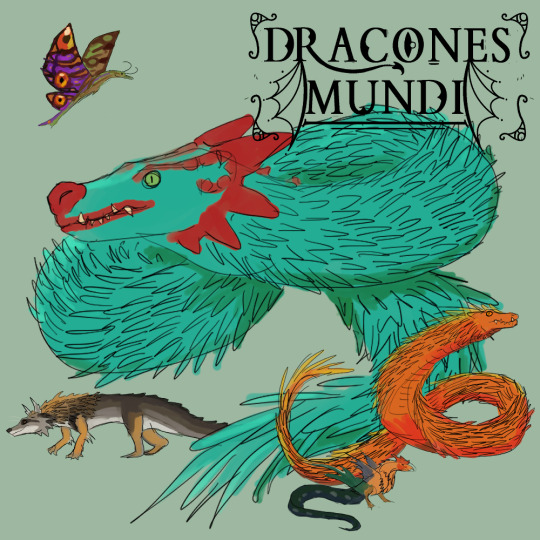
The first dragon I will discuss is the coatl. Coameh have two subspecies: the dry forest coatl and the rainforest coatl (excuse to base appearances closer to Aztec or Maya depictions of coameh, Maya = rainforest, Aztec = dryforest), depicted here is a dry forest coatl; the rainforest one is larger with a smaller frill. These are found in Mexico.
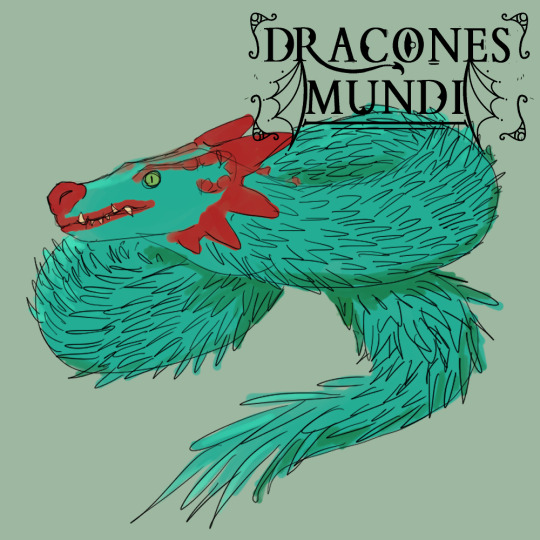
Closely related to the coatl is the flaming serpent, with several more subspecies (tlilcoatl, cherruve, tsamtás, mboitatá, plus a few others I will describe when I do North American dragon post) - it is an iridescent dragon, sometimes black with gold shining iridescence, but usually flame-coloured. When swimming through the air, catching sunlight, it looks like a living fire. These are found throughout Mexico and South America (and, as I mentioned, some in North America too!)
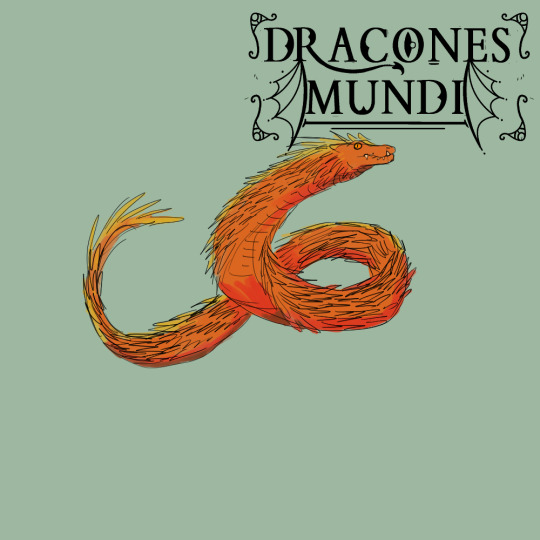
Then we have a dragon from Patagonia, the nguruvilu or fox serpent (I may make longer and add the distinctive tail with a claw on the end of it, this was a rushed doodle just getting the gist of half-fox-half-serpent while still fitting with the Dracones Mundi crocodile-dragon vibe) (the fox colours are based on the grey fox found in South America)
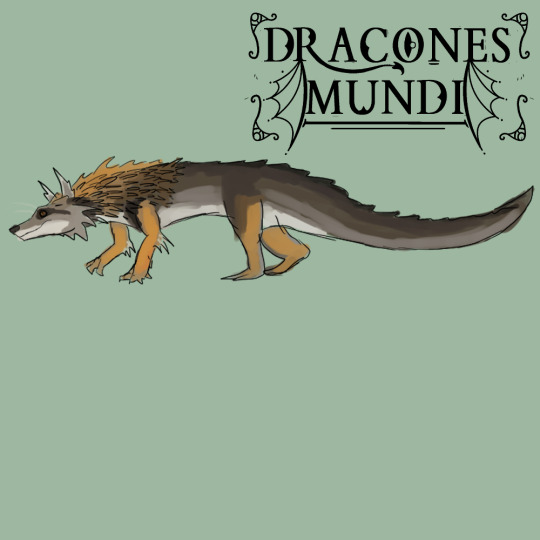
And lastly we have a 100% made up based loosely on pop culture 'fae dragon' or 'butterfly dragon', part of the winged serpent family in Dracones Mundi (dragons with 4 wings and very small arms and a distinctive tail fluke). As I had a group of 4-winged dragons, I thought a butterfly dragon might be fun! I'm plopping these into the Amazon rainforest.
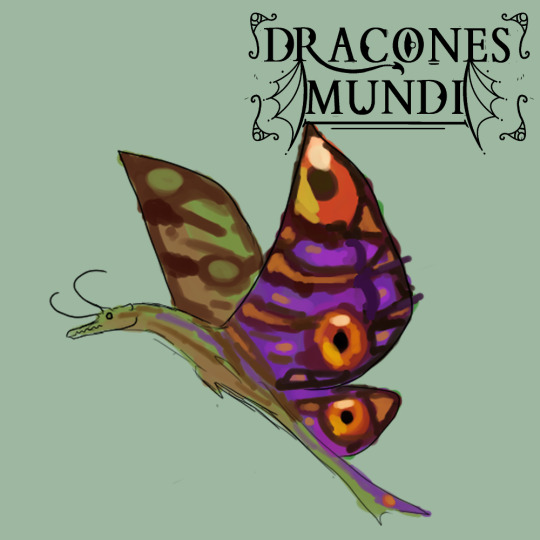
Also, cockatrices have a worldwide distribution so they are found in Mesoamerica and South America too!
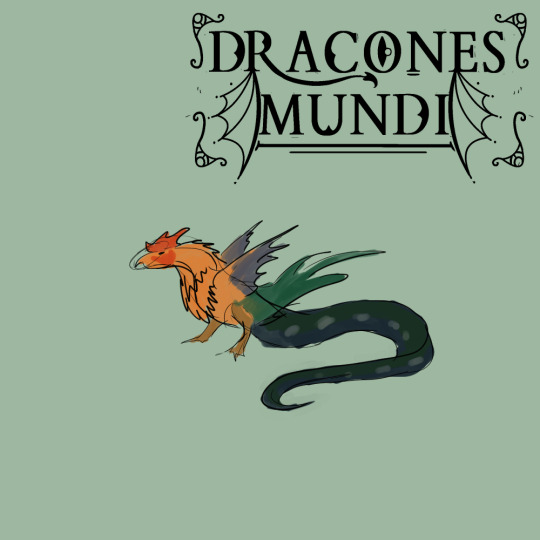
55 notes
·
View notes
Text
german, french and persian forenames + quenya names
Afshana Aglie Aichidren Aingas Aiterondë Akhtyan Alandómin Aldarman Aldómë Aliest Aling Almert Almona Amaits Amarans Amarick Amasb Amaston Ancinque Angar Angiver Animeh Annel Annelm Anuled Aragen Arangaz Araucto Arclan Armon Arous Arowsh Arstess Artalan Artar Artars Artië Arvate Atahy Atthi Aucánuen Aurëa Avassetto Avina Axando Azgoly Baheive Bamzeh Beefer Beira Berion Blendiet Brick Brina Brindo Brion Calan Caldeds Calie Cands Carie Caser Caster Cavante Celone Chayon Chelda Chert Cirel Cirion Coameh Coamide Coldë Combeh Cormo Corna Corzo Culimoz Cushe Cánushann Cécir Daltár Darha Deerain Degfrayed Devooss Diand Dortië Dwarasa Dwaron Elaur Eldaine Eldends Eldil Eldooz Eleght Elias Elkidde Elolf Eloro Elory Elvess Emeemo Emenrië Endictule Enval Ererrasb Eruishan Erulaindë Eseen Evendú Eälómë Eären Fahmarkne Faland Fands Farmarsun Faturua Fazyamdan Femir Feria Feriessë Findiave Finer Fingwar Finor Firabe Firim Forander Formin Frastir Fruin Galmo Gemacquë Gentárol Gerionri Gestary Gesturië Ghaden Ghayvanow Ghorbod Ghose Giftar Gireent Gisana Goldan Goldë Golim Graffix Guelin Guited Gélianes Hajid Halie Hanitë Harabarië Hasbeh Heanórion Heatar Hehri Heinwë Helcaled Heles Heluns Hereid Hereyfor Hernë Heron Heyel Hiddle Hider Hilië Hirsille Houza Hrick Hrion Hráva Hríma Hrína Hrónamen Hröandace Hught Hyarmeed Ilinds Ilmas Ilmund Ilwer Incardad Inzoos Isilmangs Isimo Isincie Isindë Isirab Ismangar Istirë Itand Jamil Jeadinga Jeatitë Joshan Jostarine Julan Kabiands Karger Kastia Kemindo Khour Kiary Kinquendo Kokhou Kokon Koommírë Korth Kouth Lacilië Laine Laity Lalies Lalima Lalmo Lalving Laman Lasto Laugus Laulmsh Leavasab Lentárë Lichel Likorsts Linahma Linasa Lincamese Linessa Linus Linóred Loacard Lofiste Loohran Ludwildë Lómeent Lómildalf Lómëan Macir Mahin Mahlaca Mahlar Mairë Majeaurë Mallime Mandë Manoldo Manónat Maredrion Maree Marifer Marjassë Massëanno Maylvadi Mazalëa Miched Millentz Miser Morgissa Moronders Mozad Mundrinë Nachird Nanda Nanule Narmë Nasabin Navalë Navera Nenthan Nessever Nestlan Nicil Nictose Nintlar Niquen Nobing Nolby Noldam Norbolph Nísina Nóreden Ohtir Olord Ondie Ondósar Orofte Outharix Outtar Pancire Pançois Parmenim Paros Pettopeth Philmiry Placil Poodacar Pouionthi Poushil Pranárë Prend Pujmair Quene Quentár Rairsh Ranie Relenisto Rette Rigiz Rinowince Rocécil Rokarma Royad Russë Rédred Régin Rémid Rínaxë Rívin Rómehrak Rómens Rúmed Saberind Sador Sahael Sakid Samshan Santo Sarays Seendon Seyvoises Shabna Shandóme Shanyast Shaph Sharik Shehteron Shent Shiaver Shieghte Shindo Shiranda Shomúrëa Simen Sindo Siran Siree Slambo Slarvandi Slein Sohele Sondiler Sorien Spide Spiellië Spienz Spiry Stara Starsha Stodar Stohínala Struhan Sumbar Suntan Sunto Sylvic Taharóla Tahaurë Taught Taureste Telma Thadoon Thlala Tholdow Timascal Tirie Titimash Toing Tolearrol Tolintë Tophil Tougua Touneme Tumba Tumbiz Turenala Turwer Turélin Twane Tyate Tárins Túried Uinessë Uldailmak Ulinë Ulmanned Unduinë Upred Ustin Uturon Vageste Valflowne Valigh Valissë Vallivina Vaneh Vanturus Vaseentz Viettar Vinessa Vinrily Vinwë Viéval Vorlened Vásabbar Warinqua Wavairall Wighta Willórë Wizarst Yasta Yavent Yelyneh Yáromen Yárëa Zamar Zamene Zercills Zoyari Élaurta Éminested Évari Írildorn Ñollë Ñololl Ólaciel Úmacamber Úmakilan Úmast
1 note
·
View note
Note
In one post you have named two dragons "dryforest coatl" and "rainforest coatl", what was the lore and distinction behind those two, and do you still have them(maybe as subspecies?)
They are subspecies! Rainforest coatl is larger with a shorter ‘wattle mane’, and has a more pronounced nose bulb and lips compared to the dryforest coatl. The rainforest coatl is based on Maya depictions of coameh while the dryforest one is based on Aztec depictions.
Lorewise there isn't a huge difference in their behaviour or anything, so they share one chapter for feathered coameh, but having two distinct subspecies means I can talk about different feathered serpent folklore without lumping everyone's stories and legends in one melting pot.
5 notes
·
View notes
Text
Happy Dracones Monday! Firedrakes!
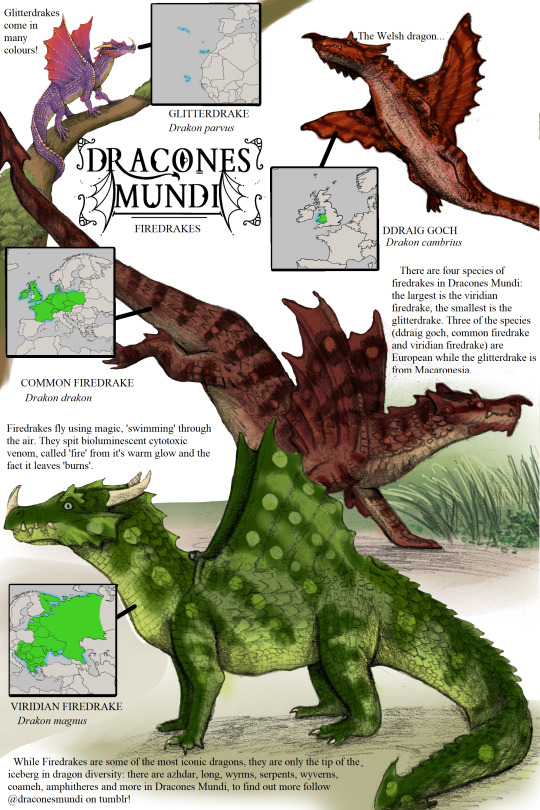
Happy Dracones Monday! This Monday we're looking at four dragon species at once, the firedrakes! Here they are, approximately to scale with eachother.
The glitterdrake is the smallest, the size of a large lizard or small cat. They live in laurel forests on Macaronesian Islands, in the Atlantic near Africa. Glitterdrakes aren't based on mythology; I put them on Macaronesia because I couldn't find Macaronesian dragon mythology but I am trying to put dragons EVERYWHERE on the map. Also, putting these dragons on an archipelago of islands means I can have a lot of island subspecies and colour morphs - glitterdrakes represent colourful fantasy dragons, so having them come in every colour (sapphire blue, ruby red, emerald green, royal purple, burning gold, shining silver etc.) was important to me.
The Welsh dragon is smaller than the other European firedrakes at 1.5 meters. They are no less fierce - there aren't any common firedrakes in Wales as a common firedrake cannot maintain a territory there for long. Originally I had the Welsh dragon as a subspecies of the common firedrake, but decided that this dragon had so much personality and folklore that it could get it's own chapter.
The common firedrake is found in Western Europe, 4m long. When designing these I noticed in a lot of heraldry dragons don't seem to have horns? Ears yes, but hornless? Also I noticed that dragons in heraldry tend to have the dorsal finlets from the back of the head to between their shoulders, but no further, which is something I have kept for all my firedrake species.
The viridian firedrake is the largest firedrake species, over 5m long. They are found in Eastern and Southern Europe, and in Russia. I based their appearance on old storybook illustrations to make them look very 'classic', which is why they have horns and cheek frills compared to the more heraldic and hornless common firedrake.
Rant about the term 'firedrake' under the cut! :)
In other creative works, these are called 'classic dragons', 'European dragons', 'true dragons' and 'Western dragons', but I am not a fan of these terms - 'true dragon' implies other dragons are untrue dragons, which is nonsense. 'Western dragon' or 'European dragon' is largely accurate (the 4 legged 2 winged dragon design is common in Europe and the West) but there are other Western and European dragons (wyrms and wyverns) and I find these terms confusing when other types of dragons are taken into account. Also, some Asian dragons also have 4 legs and 2 wings. 'Classic' dragons... serpentine and wyrmish dragons are more classic than 4 legged 2 winged firebreathers, etc.
I went with 'firedrake' as a term for these dragons because 'drake', 'drachen', 'ddraig', 'drac', 'drak' and 'dreki' are all words for dragons like this in European languages, and because firedrake is a word used in literature like some translations of Beowulf and, of course, Tolkien's Legendarium (firedrake comes from Old English fȳrdraca). I think it's a good word that easily conjures up fire breathing four legged, two winged dragons without making them more 'true' or 'classic' than other dragon types or tying them specifically to 'European' and 'Western' countries.
In Dracones Mundi I really try to get a huge diversity of dragons across to the readers. There are around 68 dragon species in this project, only 4 of which are firedrakes. I want to show readers there is more to dragon mythology than "here is a western dragon, they are evil and associated with fire, here is an eastern dragon, they are good and associated with water" - I want to dig deeper. I want people to know about azhdarha, about cuélebres, about coameh. So I'm shining the spotlight away from these firedrakes and trying to make them a small part of a much larger discussion. :)
#Dracones Mundi#Dracones Monday#Firedrakes#Dragons#Schedulling firedrake post for the monday before the firedrake plushies restock on friday hehe#Firedrake plushies found on Barksbog website on Friday 24th May 2024
224 notes
·
View notes
Text
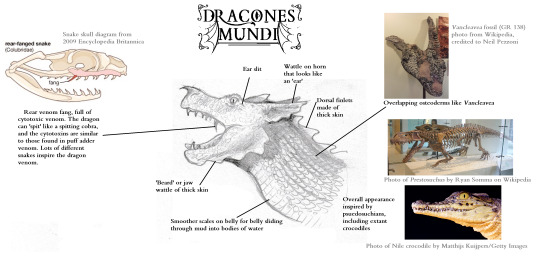
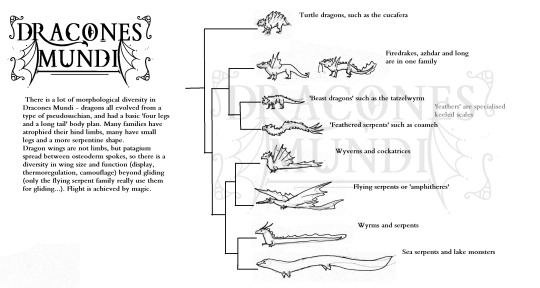
Dracones Mundi infographics to explain some of the dragon design features in my project :3
Image IDs in alt text or below the cut:
A labelled diagram depicting a dragon’s head. Labels are: ear slit. Wattle on horn that looks like an ‘ear’. Dorsal finlets made of thick skin. Overlapping osteoderms like Vancleavea (accompanied by Vancleavea fossil photo). Overall appearance inspired by pseuedosuchians, including extant crocodiles (accompanied by skeletal mount of Prestosuchus and a photo of a baby Nile crocodile). Smoother scales on belly for sliding though mud into bodies of water. ‘Beard’ or jaw wattle of thick skin. Rear venom fang, full of cytotoxic venom. The dragon can ‘spit’ like a spitting cobra, and the cytotoxins are similar to those found in puff adder venom. Lots of different snakes inspire dragon venom (accompanied by diagram of snake skull).
A dragon family tree accompanied by a paragraph of text. Text reads: There is a lot of morphological diversity in Dracones Mundi – dragons all evolved from a type of pseudosuchian, and had a basic ‘four legs and a long tail' body plan. Many families have atrophied their hind limbs, many have small legs and more serpentine shape. Dragon wings are not limbs, but patagium spread between osteoderm spokes, so there is a diversity in wing size and function (display, thermoregulation, camouflage) beyond gliding (only the flying serpent family really use them for gliding…). Flight is achieved by magic.
The dragons on the family tree are: turtle dragons, such as the cucafera. Firedrakes, azhdar and long are in one family. ‘Beast dragons’ such as the tatzelwyrm. ‘Feathered serpents’ such as coameh. Wyverns and cockatrices. Flying serpents or ‘amphitheres’. Wyrms and serpents. Sea serpents and lake monsters.
151 notes
·
View notes
Note
Were the feathered serpents ever given wings by the aztecs/mayans or was that added later on?
The Maya and the Aztecs did not give their feathered serpents wings, as far as I know!
I may be incorrect here, but I think the 'winged feathered serpent in Mesoamerica' thing became popular from the Dragonology books by Dugald Steer. Dragonology includes the 'Mexican Amphithere', a winged feathered serpent associated with Quetzalcoatl and Kukulkan. The world 'amphithere' is from European heraldry (you can probably tell from a certain French-ness in the word 'amphithere'), and the Dragonology team merged 'winged serpent amphithere' with 'feathered serpent coatl' to create their dragon design, which caught on as a popular idea in a lot of fantasy art. As far as I know, winged feathered serpents from Mesoamerica are a fantasy art convention whereas wingless feathered serpents are more in keeping with art history from that area.
There are feathered and winged serpents in mythology, but they are not coameh from Mesoamerica - I don't have access to my books right now so off the top of my head I can only think of the gwiber from Wales.
#Asks#I might answer a few asks today - still homeless but I am at a friend's place and I'm feeling more relaxed#can only answer questions that I don't need to double check things for#and only answer questions when I'm not having top notch banter with a pal
186 notes
·
View notes
Text

Happy Dracones Monday! Today's dragon is the flaming serpent!
These dragons have long bladelike scales which are naturally brown or black but flash with brillian red-orange fire colours in many lighting conditions. They are both aerial and aquatic predators, flying by magically powered flight, and as they move their black-fire colouration makes them look like a flickering flame. Their closest relatives are the coameh, or feathered serpents, which have green-blue iridescence, and they are in the feathered serpent genus. The flaming serpent species Pennaserpens ignis is found throughout North, South and Mesoamerica, with a few distinctive subspecies:
Boitatá (P. ignis mboitata) - found in Brazil, the most common subspecies of flaming serpent.
Gaasyendietha (P. ignis onteriois) - based on Seneca mythology, largest subspecies.
Tlilcoatl or acoatl (P. ignis coatlis) - based on Mexican folklore, made distinct from the other subspecies by it's forked tail
Cherruve (P. ignis volcanis) - based on Chilean folklore
Tsamtás serpents (P. ignis tsamtas) - based on Nivaklé mythology
Follow Dracones Mundi for a new dragon every monday @draconesmundi
8 notes
·
View notes
Text
Smaugust Day 14: Feathered

Here is a feathered serpent, a coatl from Mesoamerica. In Dracones Mundi these are dragons covered in psuedopennae (flat, long scales that look like feathers from a distance) with a strong blue/green iridescence. Surprisingly these colours afford the dragon good camouflage; when hidden among the leaves of the trees the shaggy appearance of the scales hides the dragon’s outline while the reflective colours blend in with the greens of the forest.
There are three subspecies of coatl in Dracones Mundi - the rainforest coatl (based on Maya depictions of serpents), the dryforest coatl (based on Aztec depictions of serpents), and then the awanyu, which I haven’t decided much about aside from it being the feathered serpent from Tewa mythology (and is therefore much more northern than the rainforest and dryforest coameh).
Quetzalcoatl and Kukulkan are the ‘feathered serpent gods’ in Aztec and Maya mythology, and Quetzalcoatl in particular is very popular in western media - the name ‘Quetzalcoalt’ means ‘plumed/feathered serpent’ - and the quetzal bird is named after it’s long plumed tail. I’ve based the coatl’s colour scheme on the quetzal.
This Smaugust I am using this prompt list: https://draconesmundi.tumblr.com/post/625107202033778688
16 notes
·
View notes
Note
Since you're basing some of your art off the actual artwork done by the countries, what are some of the differences you've noticed between how different East Asian countries depict dragons? I know that Druk lacks the cheek tusks, and Japanese dragons tend to have longer heads and spikier beards when compared to the dragons of China, but what are some other trends you've noticed?
Those are the main differences, then I’ve got a few specific things like yellow chinese dragons have a long white whisker under each eye, persian dragons have a long bit of beard in the corner of their jaws, coameh have three tusks at the corner of their mouths, heraldic european dragons have dorsal fins that stop between the shoulders, green wyverns tend to have eye spots on their wings etc. etc. If anything appears in multiple artworks contemporary to the time dragons were commonly drawn I’ll usually make a note of it and add it to my dragon’s designs. There are no dragon designs in Dracones Mundi which are 100% my own imagination with no influence, each one is made based on dragon descriptions and drawings of the cultures (with the exception of the Pink Dragon, who is tangentially based on dragon dance puppets but mostly based on pink dragon fruit). Of course I feel free to interpret drawings differently as some drawings are of mammalian or lizardlike animals with feathered bird wings while I am drawing very crocodilian dragons, but I tend to gather as much information as possible on the dragon I want to depict, and then add these details into the art.
This is why dragon designs change as I learn more about the artwork and written accounts of various myths!
6 notes
·
View notes